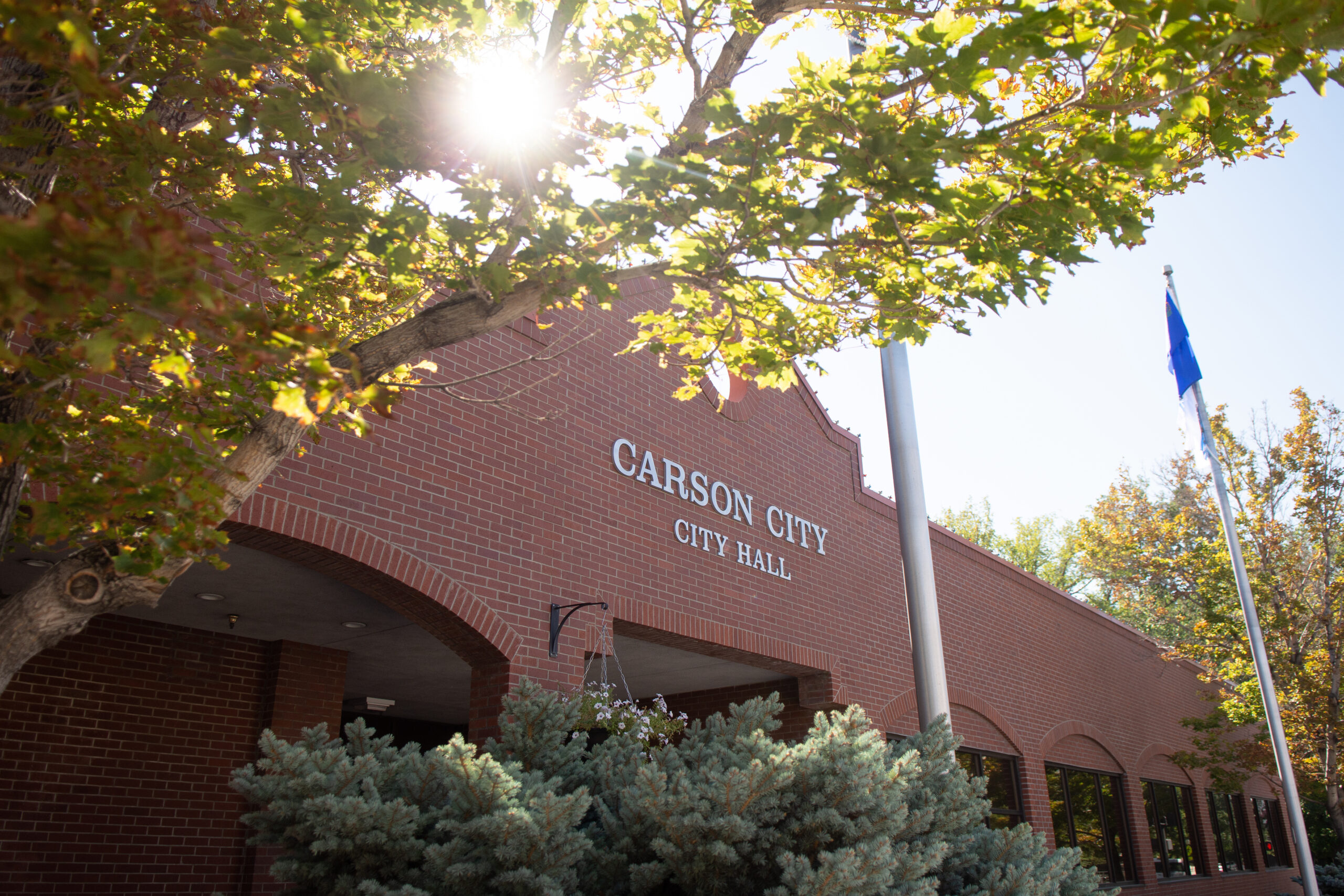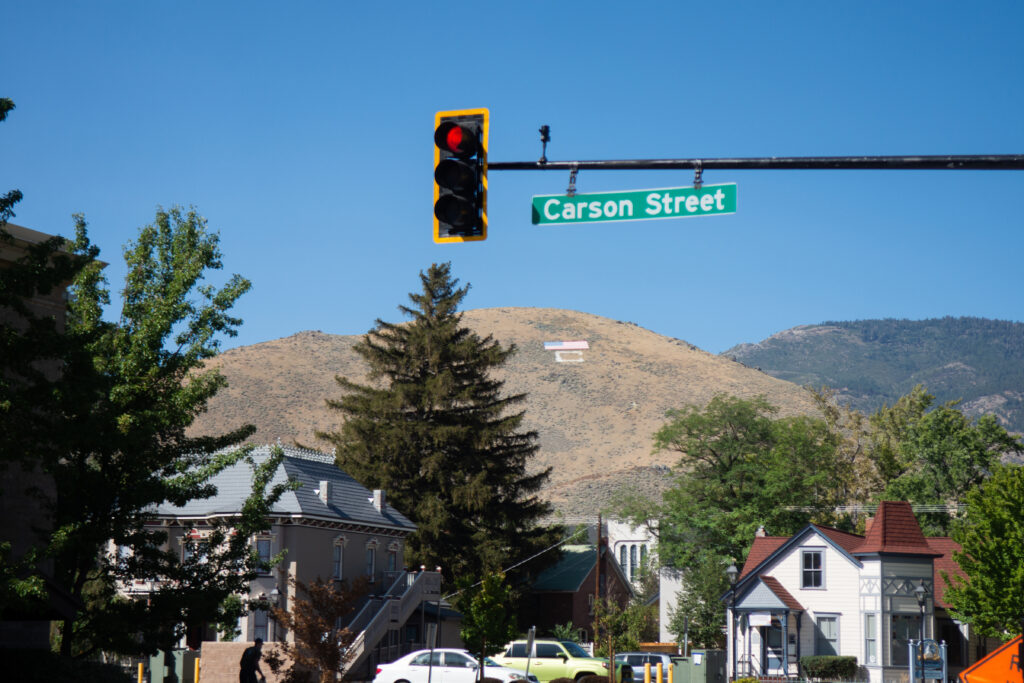Water, development, housing top of mind for Carson City supervisor candidates

How should development be managed? What about housing affordability? And what will be done to improve roads, conserve water and reduce homelessness?
These are some of the questions facing candidates for the Carson City Board of Supervisors, the governing body that oversees everything in the capital city from local ordinances to sign design.
Roughly 59,000 people call Carson City home, according to the latest Census estimates, and that number swells when biennial legislative sessions bring lawmakers, lobbyists and others to town. Like the rest of Northern Nevada, Carson City — which is the state’s only independent city and is roughly a half-hour drive from both Reno and the southern portion of Lake Tahoe — has felt the pinch of a sizzling real-estate market in recent years.
Similar to a city council, the five-member board consists of the mayor and supervisors representing four wards. The Ward 1 and Ward 3 seats are up for election in November, and though voters across the city can help select the new supervisors, the candidates must reside in the ward they would represent for the four-year terms.
Candidates highlighted affordable housing, growth management, water conservation, homelessness, roads, and more as important issues facing Carson City voters going into the election season.

Ward 1: Stacey Giomi and Wade Bradshaw
Incumbent Stacey Giomi has spent much of his life in public service — first, as a firefighter and Carson City Fire Chief, and now as the director of facilities security and emergency preparedness for the Carson City-based Nevada Health Centers. He has also served as president of Advocates to End Domestic Violence and as secretary for the RSVP program, which provides services to seniors.
Giomi said his passion for public service comes from his days working in the fire service.
“You develop a connection in a lot of people’s lives in a really unique way,” Giomi said. “For a brief moment, you develop that connection with someone you’re trying to help on the worst day of their life, a connection they wouldn't share with even their closest friend. That clicked for me about halfway through my career, to realize that connection comes with a lot of responsibility, and a lot of compassion.”
Giomi’s opponent, Wade Bradshaw, was born in Carson City before moving with his family to Tonopah, where he graduated high school. After high school, Bradshaw returned to Carson City and earned an associates degree in electronics from Western Nevada College. Bradshaw spent several years working for Nevada Medicaid as an electronic claims coordinator.
Bradshaw said at the heart of his campaign is a desire to develop a rapport with residents and he has already begun this approach by going door to door to meet people in person.
“I want to understand firsthand the problems the residents of Carson City face and consider their suggestions where possible,” Bradshaw said. “Overall, helping the city to provide fiscally responsible, efficient city services will be my guiding principle.”
Housing
Two concerns under the broader category of housing — affordability and development — have emerged as talking points during the campaign. The city has faced questions of whether housing is affordable and attainable for the average citizen and whether development should be capped or stopped altogether.
While some residents cite growth as an issue, Giomi said growth and affordability do not go hand-in-hand.
“Unfortunately, our housing market is affected more by people leaving California and coming here with a lot of cash,” he said. “Housing prices are market-driven. It isn’t just us; the whole region is growing, but we’re growing slower because we have a growth management cap.”
That cap, Giomi said, was first enacted by the “forward-thinking” city leaders in the 1970s, and has regulated growth to between 1.2 percent to 1.3 percent.
“The smartest thing we can do is make sure that we’re maintaining growth at a capacity that we can support, and that our infrastructure can support,” he said.
However, when a limited number of developments are being built each year, and with prices skyrocketing for both rent and home purchases, many residents feel they are being left in the lurch.
“That’s why we’re doing this affordable housing project,” Giomi said. “Out of anything we’ve done over the past four years, I am so excited for this project to be completed.”
Construction of 160 units for the affordable housing project — known as Sierra Flats — is underway, and it will guarantee a below-market rental rates for a minimum of 51 years, catering to veterans, seniors, and families that receive federal Section 8 or Housing and Urban Development (HUD) vouchers.
“You can’t find anyone to take Section 8 vouchers when [a landlord] can get $1,500 a month for a two-bedroom house,” Giomi said. “This is a big step the city took. One-hundred sixty units won’t solve all our problems, but it’s a huge step in the right direction.”
Giomi would also like to take a look at requiring new developers to include a certain number of affordable housing units in their planned developments, though he said it “could get tricky” when it comes to zoning requirements.
“Still, I think it’s at the very least worth exploring to try and integrate some affordability with the developments that are going up,” Giomi said.
Bradshaw takes a different approach to housing, and believes all development should be paused to examine the short- and long-term effects of current building plans.
“More and more residents do not like high-density housing and conversion from the rural to an urban landscape to meet the growing demand of affordable housing,” Bradshaw said. “Current residents fear that Carson City is losing its soul. It may be too late to alter the trajectory as many permits have been approved already and construction is in progress.”
Bradshaw agreed, however, that housing market issues are being exacerbated by more people moving from other states, especially California.
“The prosperity of a community is measured by home ownership,” Bradshaw said. “Carson City is experiencing unprecedented migration from other states, especially California, which has resulted in a booming housing market favoring existing owners but making it difficult [for] first-time home buyers.”
However, Bradshaw added the issue might resolve itself as a “downturn in the market will offer potential home owners new opportunities to enter the market.”
He also believes the city should explore future partnerships between a variety of nonprofit and government entities to keep current residents from being pushed out.
“Regulations on zoning, master plan updates and occupancy may make the American Dream possible for the new generation of families,” he said.
Water
As drought continues to affect Northern Nevada and much of the West, concerns about water have coincided with conversations about development. But Bradshaw said lack of information has led to some public misunderstandings.
“We currently have enough water for the residents,” Bradshaw said. “However, the concern is whether there is enough water for the projected growth in our community. We need to ensure our resources can sustain the approved growth for future generations of residents, and secure the needed water supply.”
Douglas County supplies Carson City with water through a purchase agreement, Bradshaw said, and the city is currently expanding its Quill Water Treatment Plant to handle greater quantities of water purification for homes.
“During summer’s peak water usage when surface water is less, the city must rely more on its 32 groundwater wells,” said Bradshaw. “Based on past and current growth reports, the Water Utility Manager projects ‘build out’ to allow for increased water demands. There needs to (be) further examination, continual monitoring and discussion to ensure secure water supply.”
Giomi says that Carson City has a surplus of water, and water conservancy is calculated into every development consideration.
Approximately three years ago, said Giomi, the city finished a comprehensive water study that ties the water and water system directly to the master plan.
“The water study measures the water rights we have, our water production capability, and it matches [those results] to the number of housing units we can build,” Giomi said.
Giomi does not believe that, at least in his lifetime, Carson City will reach the population cap of 75,000 that the master plan has set forth as the build-out that the city can support.
“I’m not going to be alive when we hit that number,” said Giomi. “We’ve only been growing at 1.2 or 1.3 percent per year for almost the last 40 years. It goes back to the growth component. We aren’t one of those boom or bust towns. We have slow, studied, measured growth, and our resources match that growth.”
The city actually has a surplus of water, Giomi said, which he believes most residents do not understand.
“Even despite the drought, we have a surplus, and we continue to look for more water and acquire more water rights,” said Giomi. “Our water studies prove that we have the water to meet our growth.”
Roads
When it comes to constituent concerns, Giomi said roads and homelessness are among the most common issues raised.
The deterioration of roads in Carson City has been an issue for years and, in some areas, several decades, due to a constant deficit and lack of funding in the roads budget year after year.
“There’s no easy answer to the roads issue,” Giomi said. “I don’t think we can solve the road issue at the local level – it’s a lot bigger than that.”
While more drivers are switching to hybrid or electric vehicles to be more environmentally-conscious (or wallet-conscious), that creates a deficit in the gas taxes that go toward road construction and maintenance. Carson City also charges less in per-gallon gasoline taxes than Washoe or Clark counties, both of which have adopted indexing that allow gas taxes to rise with inflation but help pay for additional road projects and improvements.
“Electric cars aren’t paying the fuel tax, and hybrids are paying much less,” Giomi said. “That’s something that really needs to be solved at the state or federal level. We could raise our gas tax, but that would be counterproductive, not to mention it would not end up generating that much money.”
The state has suggested some potential fees, such as a mileage fee, but Giomi sees problems with those as well.
“For example, if someone is commuting to California a couple times a week, and you’re paying taxes or a mileage fee, you’re not even driving all of those miles in Nevada,” Giomi said. “I don’t know what the answer is.”
A road-related ballot question will be coming to the local ballot in November regarding continuation of the diesel tax. The local ballot question states that the diesel tax generates about $500,000 annually, which goes into the road fund. However, if voters choose to discontinue the diesel tax, that revenue will be lost.
However, the roads aren’t simply being left to crumble into disrepair, according to Giomi. While the city is not focusing on building new roads, the existing road funds are being used for maintaining city roadways. For all new roads being built in new communities, developers are being tasked with their installation, and are prorated for roads that are impacted by or connected to those developments, such as the recent Lompa Ranch development.
“Having developers pay a prorated share of the roadway, as well as improvements that their developments affect – that’s on them,” Giomi said.
Recently, $2 million in city funding was dedicated to neighborhood road improvements, split evenly between Carson City’s five transportation districts to fund “preventative maintenance” of those roadways.
“The citizens are not happy with the state of the roads,” Bradshaw said. “People are concerned and want to know what our priorities should be as a city. The city budget is complex, but prioritization of limited funds is a key decision of this board. Even more important is asking the residents which spending should be a priority. Unattended, future maintenance of assets becomes more costly.”
Bradshaw believes the city needs an “annual recovery plan” to reallocate budgeted funds, especially because American Rescue Plan funds enabled the city to bring forward capital projects already budgeted in the future.
Homelessness
Following the pandemic and increasing housing costs, the rate of individuals dealing with homelessness has increased both locally and nationwide.
Bradshaw believes that nonprofits are able to assist those dealing with homelessness.
“During the pandemic, there was a moratorium on rent increases plus direct payments from the federal government,” Bradshaw said. “Here in Carson City, there is an amazing organization called Friends In Service Helping. FISH specializes in supporting displaced individuals and families in getting back on their feet by providing assistance with clothing, education, resume building, food, and housing.”
Along with FISH, there are other supportive organizations in Carson City, and Bradshaw supports assisting those nonprofits to “fulfill their missions.”
Giomi took a different approach, stating that providing stable housing has to be the first act in helping people overcome homelessness.
While building a homeless shelter might provide temporary shelter for those dealing with homelessness, it will not change their lives, Giomi said. What needs to happen instead, he said, is a “housing first” approach — the belief that lives cannot be changed until people are sheltered and safe.
“If someone isn’t housed, it’s impossible to get those services,” Giomi said. “If you don’t have a roof over your head, how could you get treatment for mental health or substance abuse issues, or even to eat properly?”
Once individuals are in a stable location, they will be able to take on other wraparound services and eventually find a job and permanent housing, Giomi said.
“That’s the goal: to take them from homelessness, to get them in their own place with an income,” Giomi said.
In Giomi’s view, though not everyone will benefit from services – because they simply do not want to engage with the program, or they are unable to complete the program for a number of reasons – not doing anything benefits no one, especially the community as a whole.
“If you put a shelter up, there's no end in sight for that,” Giomi said. “It almost seems that when you’re doing that, you’re admitting defeat. You’re saying, ‘This is all you’re going to have, you’re not going to have anything more.’ It perpetuates hopelessness. But by providing structure, getting them out of the pit of despair, combined with wraparound services, that’s what can help them get out of that hole.”

Ward 2: Jim Wells and Curt Horton
The Ward 2 race features two candidates who have prior experience in government — one on the finance side and the other in the public works realm.
James “Jim” Wells is a former Nevada budget director with more than 30 years of experience in government finance. Curtis “Curt” Horton recently retired from Carson City as its public works deputy director and has 35 years of city government experience.
Growth Management
Wells first moved to Carson City in 1972, and since that time, he has seen the capital city transform from a small town to a “medium-sized city.”
“Growth can be positive for the city, but it can negatively impact the city’s resources, especially water and sewer, traffic movement, and police and fire protective services,” Wells said.
However, Wells said the strength of the city lies in the recently adopted five-year strategic plan, which serves as a roadmap and sets the city’s priorities.
Horton said he believes the board should focus on improving road conditions and boosting staffing levels within the city government.
“Locally, the deteriorating conditions of our roadways and sidewalks [are a major issue], and some city departments are inadequately staffed to sufficiently respond to citizen requests or infrastructure demands,” Horton said.
Both candidates also weighed in on the housing situation, though their approaches to increasing affordable options are different.
“This is a difficult issue to address given the geographic constraints the city must live within,” Wells said. “The board should promote reasonable opportunities for more affordable housing but needs to be careful not to alter normal market forces. Using available resources such as the low-income housing tax credits is one way to encourage developers to invest in projects to offer affordable rents.”
Horton, on the other hand, believes public-private partnerships and incentive programs should be leveraged to help overcome the affordable housing crisis.
“[The board can] continue to explore options like public-private partnerships, offering possible incentives like functional density bonuses or reduced infrastructure fees, and use of pre-approved plans in certain serviceable locations,” Horton said.
As Carson City struggles with a lack of affordable housing, it’s also seeing an increase in the number of unsheltered people within the city. There are roughly 250 individuals experiencing homelessness living in the city as of 2021.
Horton believes the way to tackle homelessness is to use existing resources instead of dedicating city funding toward the problem.
“There are ample available resources in Carson City to support homeless populations without increasing the burden on taxpayers,” Horton said. “[There are] many local church groups, Friends in Service Helping (FISH), Health and Human Services, Nevada Rural Housing Authority, and more.”
Wells believes there is a place for the government’s assistance in helping to solve homelessness, but he said it should be a combined effort among the city, state, and nonprofits.
“This is a community problem that cannot be fixed by government alone,” Wells said. “There are many non-profit organizations whose mission is to help the homeless and under-employed.”
He noted that the state also has workforce development resources through the Employment Security Division of the Department of Employment, Training and Rehabilitation to provide training and education to assist individuals.
“This is really about matching individuals in need with the services that will help them to become successful,” Wells said. “It should not be about reinventing or duplicating services that already exist.”
Environmental Concerns
Wells believes that when it comes to development, water is only a portion of the total puzzle.
“The potential impacts of new development on the city’s resources go beyond just water,” Wells said. “Other services, especially traffic movement, police and fire protective services are impacted by continued growth.”
Wells said the Board of Supervisors should be proactive in identifying mitigation efforts to balance the impact of new development with the service needs that growth will demand. For instance, he suggested reviewing and updating the city’s planning and zoning ordinances.
Horton, meanwhile, believes that the city can continue to grow with the water that it currently uses.
“As long as we continue maintaining and improving our production and distribution systems as we are now, we should have no issues moving forward,” Horton said.
When it comes to climate change and its effect on the community, consequences can be seen throughout the year — from forest fires causing smoke-filled summers to a dwindling snowpack leaving creeks, rivers and lake beds dry.
As for whether the government should take steps to become “greener,” Horton believes the city already has integrated climate change into planning.
“The local government has already dedicated resources into effectively planning for and mitigating climate change and continues to do so,” Horton said.
Wells believes the government — and its citizens — should be doing more, but on an incremental level that does not overwhelm residents or city infrastructure.
“Government should promote conservation efforts both internally and from its citizens,” Wells said. “It is important to recognize the limitations of our natural resources. However, that doesn’t necessarily mean we should go out and replace all existing city vehicles with electric ones. It should be an incremental approach to conserve natural resources where we can.”
In closing
Wells said he has a track record of identifying and implementing process efficiencies to reduce operational costs and eliminate duplication.
“I believe residents deserve a responsive government that is conservative in spending public resources, transparent in conducting its business and accountable for decisions made on the people’s behalf,” Wells said.
His background provides him a unique insight into how government works, Wells said, and he wants to bring that experience and perspective to the Board of Supervisors to analyze the data, ask critical questions and work with other board members and city staff to make sound decisions that benefit the community.
Horton said Carson City officials are known for being “uniformly dedicated to ensuring open and honest communications,” which is what he wants to bring to the board if elected.
“My 35-plus years of experience in Carson City government has been dedicated to offering its citizens innovative outcomes and overseeing the transformation of operations to adapt to the ever-changing service demands,” Horton said. “I have firsthand experience working within Carson City’s local government, which offers a more purposeful perspective on government operations and enhances my ability to make sound decisions.”
